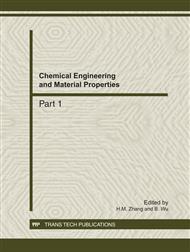[1]
R.J. Brodd, K.R. Bullock, E. Takeuchi, et al: J. Electrochem. Soc. K1 Vol. 151 (2004), p.11.
Google Scholar
[2]
A.K. Padhi, K.S. Nanjundaswamy, J.B. Goodenough: J. Electrochem. Soc. Vol. 144 (1997), p.1609.
Google Scholar
[3]
M.S. Whittingham: Chem. Rev. Vol. 104, (2004), p.4271.
Google Scholar
[4]
A.K. Padhi, K.S. Nanjundaswamy, J.B. Goodenough: J. Electrochem. Soc. Vol. 144 (1997), p.1188.
Google Scholar
[5]
A. Yamada, S.C. Chung, K. Hinokuma: J. Electrochem. Soc. Vol. 148 (2001), p.224.
Google Scholar
[6]
S. Okada, S. Sawa, M. Tabushi, et al: J. Power Sources Vol. 430 (2001), p.97.
Google Scholar
[7]
D.D. MacNeil, Z. Lu, Z. Chen, J.R. Dahn: J. Power Sources 8 (2002), p.108.
Google Scholar
[8]
D. Morgan, A. Van der Ven, G. Ceder: Electrochem. Solid State Lett. Vol. 7 (2004), p.30.
Google Scholar
[9]
M.S. Islam, D.J. Driscoll, C.A.J. Fisher, P. R Slater: Chem. Mater. Vol. 17 (2005), p.5085.
Google Scholar
[10]
M.S. Whittingham: Chem. Rev. Vol. 104 (2004), p.4271.
Google Scholar
[11]
A.S. Andersson, J.O. Thomas: J. Power Sources Vol. 97-98 (2001), p.498.
Google Scholar
[12]
X. Qin, X. Wang, Y. Zhou, et al: J. Phys. Chem. Vol. C 114 (2010), p.16806.
Google Scholar
[13]
H.C. Kang, D.K. Jun, K.W. Kim, et al: J. Power Sources Vol. 179 (2008), p.340.
Google Scholar
[14]
S.B. Lee, I.C. Jang, Y.S. Lee, et al: J. Alloys Compd. Vol. 491 (2010), p.668.
Google Scholar
[15]
M. Zhong, Z. Zhou: Solid State Ionics Vol. 181 (2010), p.1607.
Google Scholar
[16]
J. Ni, H. Zhou, J. Chen, X. Zhang: Materials Letters Vol. 59 (2005), p.2361.
Google Scholar
[17]
H. Masashi, K. Keiichi, S. Manabu, et al: J. Power Sources Vol. 119–121 (2003), p.258.
Google Scholar
[18]
K. Dokko, S. Koizumi, K. Sharaishi, K. Kanamura: J. Power Sources Vol. 165 (2007), p.656.
DOI: 10.1016/j.jpowsour.2006.10.027
Google Scholar
[19]
K. Akira, S. Shinya, M. Masaru: J. Electroceram Vol. 24 (2010), p.69.
Google Scholar
[20]
J.J. Chen, S.J. Wang, M.S. Whittingham: J. Power Sources Vol. 174 (2007), p.442.
Google Scholar
[21]
Q. Song, X. Ou, Z. Wang, et al: Materials Research Bulletin (2011).
Google Scholar
[22]
J.J. Chen, M.S. Whittingham: Electrochem Commun. Vol. 8 (2006), p.855.
Google Scholar
[23]
J.J. Chen, M.J. Vacchio, M.S. Whittingham, et al: Solid State Ionics Vol. 178 (2008), p.1676.
Google Scholar
[24]
Z. Lu, H. Chen, Rosa Robert, et al: Chem. Mater. Vol. 23 (2011), p.2848.
Google Scholar
[25]
K. Dokko, S. Koizumi, K. Kanamura: Chem. Lett. Vol. 35(2006), p.338.
Google Scholar
[26]
J. Qian, M. Zhou, Y. Cao, et al: J. Phys. Chem. Vol. C 114 (2010), p.3477.
Google Scholar
[27]
Y. Wang, E. Hosono, H. Zhou, et al: Angew. Chem. Int. Ed. Vol. 47 (2008), p.7461.
Google Scholar
[28]
Huang X, et al : Mater Charact (2010).
Google Scholar


